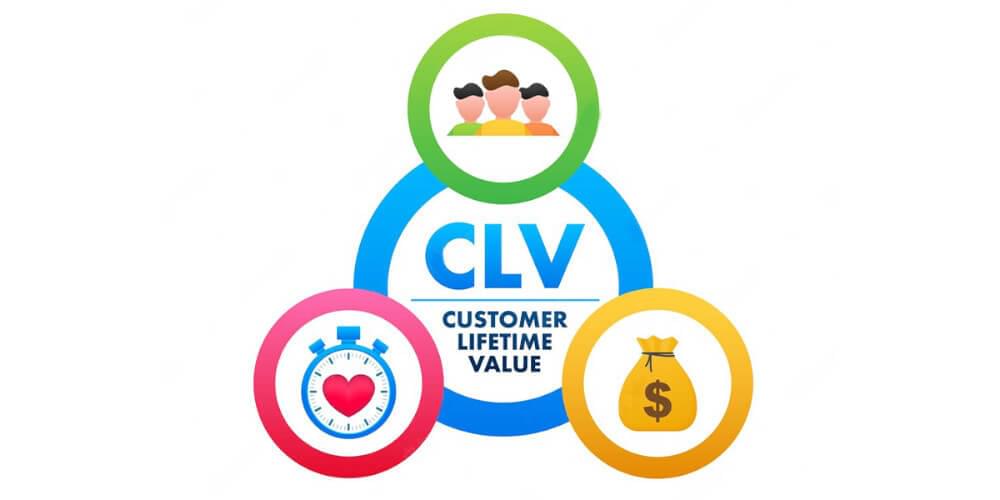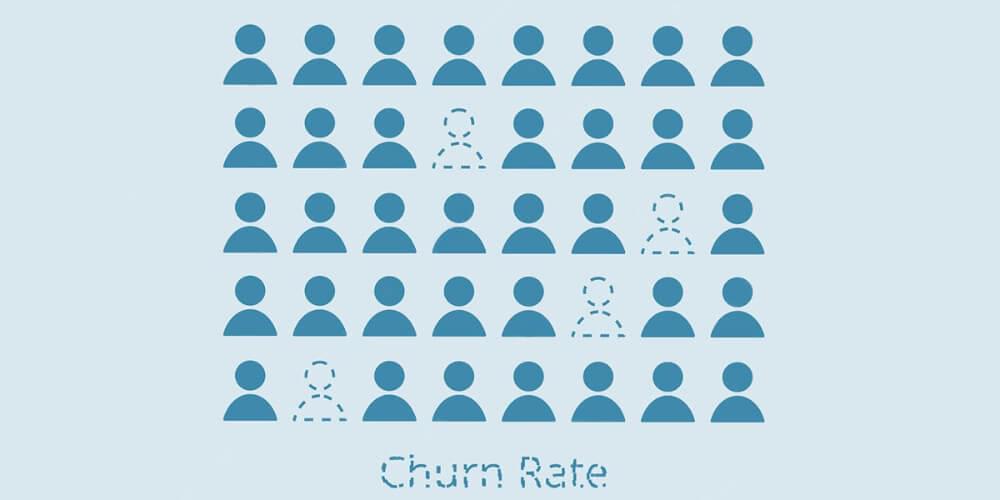
What are Customer Lifetime Value and Churn Rate?
15 mins readSep 19, 2022

The online world has become a huge part of every business. As a business strategist, you need to be aware of how well your brand performs on all of your digital platforms. After being armed with smart metrics and analytics tools, drilling down your users’ preferences, and once you have figured out the ways to satisfy them. The next big step is knowing the customer’s lifetime value and churn rate.
This blog will mainly focus on two critical concepts—the customer lifetime value(CLV) and churn rate. A deeper understanding of these factors will help you know how to maintain your website’s success and make better business decisions.
So let’s get down to business.
What are customer lifetime value (CLV) and churn rate—are they important to your business?
CLV and churn rate work indirectly proportional to each other. The more customer lifetime value you have, the lesser the churn rate will have its worse effects on your website. On the other hand, if you have less customer lifetime value, your website’s churn rate goes higher.
Let’s quickly walk you through what customer lifetime value means to your business, especially when dealing with monthly subscriptions and memberships.
What is customer lifetime value?
Customer lifetime value is the estimated net profit attributed to the entire future relationship with a customer. In other words, it predicts how much revenue a business can generate from a single customer throughout their relationship.
CLV is essential as it allows businesses to see beyond simply acquiring new customers and focus on retaining existing ones.
A high customer lifetime value indicates that a company successfully sells to its target market and provides a good product or service value.
Several factors go into calculating customer lifetime value, including purchase frequency, average order size, gross margin, and retention rate.
Here’s an example: let’s say you run a subscription-based service that costs $10 per month. After analyzing your data, you find that the average customer spends 18 months with your service and has a churn rate of 5%.
Based on these numbers, we can calculate that the average customer contributes $180 in gross profit ($10 x 18 months). With a 5% churn rate, this equates to a lifetime value of $172 per customer ($180 - (5% x $180)).
Knowing your CLV helps you make informed decisions about allocating your resources. For example, if acquisition costs exceed the lifetime value of a customer, then it doesn’t make financial sense to continue investing in marketing efforts to attract new users. In this case, focusing on initiatives that improve retention and decrease churn would be more beneficial.
Customer Lifetime Value Statistics
- A 5% more retention generates a 25% more increased profit.
- Gaining a new user is between 5x and 25x more expensive than retaining an existing user.
- The ratio of converting an existing user is between 60%-70%.
- Existing users spend 67% more on average than new customers.
- 76% of businesses see CLV as an important factor for their organization

Why do you need to know customer lifetime value?
Understanding how much profit on average and each member of your website generate helps you make more informed business decisions. If you have a clear knowledge of the average CLV of your website, it means you have a deeper insight into how you can generate more profit for your business.
For instance, the average CLV of your website is $100, and you have 100 subscribers, which means your business is generating $10000 in revenue on average.
With this knowledge, now you are able to make more realistic decisions regarding budget and deciding membership fees. This knowledge can be beneficial in outlining how much you can spend on improvements, marketing, and all costs that involve managing and running your website.
How to measure the CLV of your website?
It entirely depends on the type of membership website, payment method, and subscription model you are running.
We can calculate CLV by using the example of a basic subscription plan as an example. We will multiply the monthly subscription fee with the time period they continue to pay, such as for six months or a year. For instance, one membership costs $10 per month, and the average length of this membership is six months or a year. Based on these measurements, the CLV of your members per month, six months, or one year time is $10 per month or $60 per half a year, or $120 per year.
Suppose we go down for extra charges such as sign-up fee, customization, or customer care service. Let’s suppose the sign-up fee is $10; then CLV would increase to $70 or $130 per year.
The more extra payments make it complicated to calculate the CLV. There could be extra costs, such as basic plan, standard plan, or premium plan that require different fee structures will be calculated accordingly.
In all cases, you can generate your CLV for all price structures by taking out the average cost of each member for each plan.
As you see, the CLV plays an essential part in helping your subscription website, but another factor also determines your website’s real worth.
What is the churn rate?
Having a deeper insight into your website’s churn rate is as significant as knowing the CLV. They are closely connected to each other. Whereas you always want to enhance the CLV of your website to determine more revenue, you will also want to decrease the churn rate as much as you can allow.
churn rate is about the members who say goodbye to your website over some time, usually a year. The higher the churn rate means, the more members are leaving your website or calling off their subscriptions, thereby decreasing the CLV of your website.
How can you can calculate churn rate?
The simple formula to calculate churn rate is: (Lost Customers ÷ Total Customers at the Start of Time Period) x 100.
For instance, if you start a business with 1,000 loyal users and ended the year with 750 users, your churn rate would equal 25%. This means 25% of your users took your profit somewhere else.

There could be hundreds of reasons why subscribers end their subscription. In most cases, the subscriptions can be called off involuntarily, such as the payment method of the subscriber expires. Fortunately, that kind of problem has an easy solution. Certain smart tools with the ability to reduce churn rate will help you.
In several other cases, subscribers leave your website because they no longer need to use your products or get value from this subscription. There could be a more complex problem in addressing the issue of lower CLV. But they are some easy problems you can look into to reduce your website’s churn rate.
What is more critical—the customer lifetime value(CLV) or a churn rate?
There is no clear answer to this phenomena as the customer lifetime value and churn rate metrics tightly work together or interwind. As said above, if your website has a higher churn rate, it means more subscribers are ending their subscription shortly after they join.
The higher CLV means you have a perfect user attention strategy to retain your old members or more new members are joining your subscription.
Being equipped with this information now, we know that CLV and the churn rate are widely significant to the success of your website. Nevertheless, once you have learned how to achieve and maintain a low churn rate, you can focus on increasing the CLV of your digital platforms.

How can you boast up customer lifetime value of your site?
Most business strategists use a simple trick to increase customer lifetime value: raising the membership fee. But it could be risky if you are a start-up, you cannot raise the membership fee for your products until you are 100% confident about the value your products are offered to your users. Therefore, raising the prices can potentially increase the CLV.
Nevertheless, ensure you justify your price hike to your users or satisfy them that they are not being robbed at higher prices. There are several other ways to make more revenue and increase your CLV. You can launch different events in exchange for smaller fees, such as online events, product, or book launches. If your members decide to pay for this extra money on top of their subscription fee, it will help you boast up the CLV of your website.
#1. Customer loyalty programs
There is no shadow of a doubt that customer loyalty works as the backbone of your business. Customer loyalty means it has a directly proportional relationship and directly correlates with increased customer retention and a decrease in a churn rate. It’s a long-term process to gain customer loyalty. Once you are successful in achieving it you will have brand loyalists who will advocate your products on your behalf to their friends and family. In this way, your brand will drive word-of-mouth marketing. Retaining your existing loyal customers is far easier than making new loyal ones. However, your current customer loyal customers may help you bring more new customers, and they may want to stick around for a more extended time. You must look into factors and build a customer loyalty strategy to ensure your customers are happy and satisfied with your products.
#2. Offer scalable solutions
As long as your products offer scalable solutions to your customers, they will remain loyal to your business. It would help if you had a scalable sales and marketing strategy. The company’s major revenue growth relies on sales and marketing expenses, and the company needs to optimize revenue from its efforts. If revenue decreases but the sales and marketing expenses continue to rise, the profit margin will decrease and result in loss.
Revise marketing and sales strategy as per user-centric rules. You should add up all the methods to help your user in all ways possible to earn their loyalty.
#3. A strong marketing strategy to attract new customers.
Although acquiring new customers instead of retaining an existing customer is much more expensive. But there are methods companies can adopt to optimize the on-boarding of new users. All you have to do is focus on user preferences and problems. Look for the ways you can fulfill their wishes and offer timely solutions. Remember, you and your users share the same bond of creating value and benefiting from it.
Once you learn how to deliver value to your users, your business will automatically start generating value that will help you gain more revenue and make better business decisions.
#4. Effective ways to communicate with the problems of users.
Communication is one of the traditional and best ways to build a strong relationship with your customers. There are different kinds of communication you can have with your users, such as you can ask them for feedback. So you know how to offer them timely solutions to their problems. Through chat bots’ service, you can ask queries and after knowing their problems, you can connect them with the team to look into their issue, guide them and offer them timely solutions.
It’s a wrap-up.
After being armed with the real-time value of CLV and the churn rate of your website, it is time to decide how to retain your older subscribers and bring more new members to your website.
You can look deeper into your user’s psychology, their preference, or the problems they are facing. You will have to devise a strategy to answer the issues with valuable solutions and choose the accessible ways to inform your users about the value of your products and how your products can be a game-changing factor for them.
The struggle between reducing the churn rate and increasing CLV is real. Instead of focusing on reducing the churn rate, you need to focus on how you can increase the CLV of your website. For this, you will have to look for ways to satisfy your customers for a more extended period.
With technology powering everything, and the dire need to act proactively towards change, we’ll be the sole move to survive in an ever-growing fierce competitive world.
You can grab innovative tools that come at a very budget-friendly cost and can help you discover the real-time CLV and churn rate of your website. Without the help of these tools, determining the churn rate could be a tiresome and effort-prone phenomenon. It can take your team a lot of time, and there is the possibility that those results are error-prone.
Knowing the accurate ratio of CLV and churn rate of your website is very much crucial for the growth of your business. Therefore, we can conclude that CLV and churn rate are essential to your business’s development—working in tandem.

